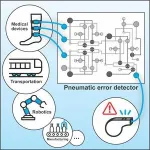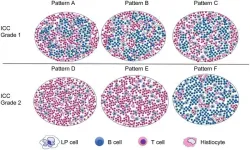(Press-News.org)
A new study on dogs found that chromatin's spatial structure has a significant role in the evolution of social behavior. Chromatin, the compact form of DNA, not only packages genetic material but also plays a crucial role in gene regulation. This study demonstrates that both the linear sequence of DNA and its three-dimensional configuration are linked to friendly behavior shaped by dog domestication, providing new insights into the molecular mechanisms underlying social traits.
Behavioral traits such as sociability are influenced by numerous genes, their interactions, environmental factors, and individual life experiences.
Because the effect of a single gene is difficult to detect, it made headlines when in 2017, Dr. Bridgett vonHoldt, a professor at Princeton University, and her team identified specific elements in the GTF2I gene in dogs, linked to Williams-Beuren syndrome (WB) in humans, characterized by hypersociability, extreme friendliness, and craniofacial abnormalities. The findings suggested that
the selection for increased friendliness in dogs involved changes in the GTF2I gene.
"This gene plays a role in neural development and pathways related to anxiety and sociability and is likely a key determinant of the friendly behavior shaped by domestication. In our current study, we aimed to investigate how genetic variants influence the 3D structure of the DNA containing this gene," says vonHoldt, lead author of the publication in BMC Genomics. "The GTF2I gene has several variants, with the ancient, wolf-like variant found in three out of ten individuals. We were curious about how the ancient and more modern variants precisely affect gene function." The gene variants originate from retrotransposons, which are mobile, self-multiplying DNA elements.
The researchers examined an intronic section of the gene, which does not produce a gene product but likely influences chromatin—the complex of DNA and proteins that make up chromosomes—spatial structure and causes differences in gene expression.
They relied on brain tissue samples from dogs provided by the ELTE University’s Canine Brain and Tissue Bank in Budapest.
"Brainstem samples were collected from pet dogs euthanized for medical reasons and donated for research. We included only dogs without major nervous system illnesses," explains Dr. Eniko Kubinyi, head of the Department of Ethology at ELTE, who established the bank with geneticist Dr. Sára Sándor and veterinarian Dr. Kálmán Czeibert andmaintains it with grants from the Hungarian Academy of Sciences. "The examined gene regulates the expression of other genes, so its expression is expected throughout the brain."
The study found that the ancient and modern variants of GTF2I affect the chromatin loop shape differently.
"Novel regulatory DNA segments caused by retrotransposon insertions are generally eliminated from the genome. Interestingly, within an intron of the GTF2I gene, the ancient wolf genome largely co-opts the inserted segment, while the modern dog genome rejects it. The presence or absence of this retrotransposon is associated with altered 3D chromatin structure at GTF2I, with possible downstream impacts on pathways regulating the extra-cellular matrix and GTF2I splicing. This is similar to the humans’ case, where many WB patients have cranio-facial abnormalities explained by extra-cellular matrix anomalies and altered GTF2I function. Essentially, we report putative molecular convergence between hyper-social behaviour in dogs and human Williams-Beuren syndrome," emphasizes Dr. Dhriti Tandon, the first author of the study.
When certain species preserve the same mutation while others do not—as seen in the difference between wolves and dogs—the regulatory effect is likely evolutionarily significant. In the absence of retrotransposons, a DNA loop present in wolves does not form in dogs, which may explain some of the differences in neurocognitive profiles and hence social behaviors between the two species.
The researchers hope that their results will highlight that not only the genomic base sequence, but also its 3D structure, influences behaviour.
Original Article: Dhriti Tandon, D., Kubinyi, E., Sándor, S., Faughnan, H., Miklósi, Á., vonHoldt, B.M. (2024) Canine Hyper-Sociability Polymorphism associated with Altered Three-Dimensional Chromatin State. BMC Genomics, 25:767. https://bmcgenomics.biomedcentral.com/articles/10.1186/s12864-024-10614-6
Funding: The study was partly supported by the Hungarian Academy of Sciences via a grant to the MTA-ELTE ‘Lendület/Momentum’ Companion Animal Research Group (grant no. PH1404/21) and the National Brain Programme 3.0 (NAP2022-I-3/2022), and the Animal Behavior Society: Student Research Grant.
END
Research Highlights:
Adults in white-collar jobs in Canada with high job strain and for whom significant efforts are met with low rewards (such as low salary or recognition) may face a 97% increased risk for developing the irregular heart rhythm condition known as atrial fibrillation, or AFib or AF, compared to workers not exposed to these work stressors.
Separately, high job strain alone was associated with an 83% higher risk of developing AFib, and effort-reward imbalance alone was associated with a 44% greater risk.
Recognizing and addressing these stressors at work may be an effective strategy ...
If it’s ever felt like everything in your body is breaking down at once, that might not be your imagination. A new Stanford Medicine study shows that many of our molecules and microorganisms dramatically rise or fall in number during our 40s and 60s.
Researchers assessed many thousands of different molecules in people from age 25 to 75, as well as their microbiomes — the bacteria, viruses and fungi that live inside us and on our skin — and found that the abundance of most molecules ...
The COVID-19 pandemic and the lockdown measures to prevent contagion resulted in extensive disruptions in children’s and adolescents’ everyday lives. A new study in Child Development from the Aarhus University Hospital in Denmark, University of California, Riverside and University of California, Davis in the United States, investigated personal memories (i.e., memories for episodes experienced in one’s own life) about the first lockdown in Denmark in Spring 2020 among children and adolescents and how this may have impacted their psychological well-being over the following year.
For context, in ...
CLEVELAND, Ohio (August 14, 2024)—With more than 24 million people globally living with dementia without a cure in sight, there is a lot of focus on ways to prevent and delay cognitive impairment. A new study suggests that severe menopause symptoms such as hot flashes and depression can negatively affect cognitive function in postmenopausal women. Results of the study are published online today in Menopause, the journal of The Menopause Society.
In conjunction with our aging population, dementia diagnoses are on the rise. It ...
The UK’s first large scale offshore mussel farm is allowing shellfish reefs to return to parts of the seabed off England’s south coast for the first time in up to 150 years, a new study has revealed.
Researchers have spent the past decade examining the environmental impact of the farm, which was first established in Lyme Bay off the coast of South Devon in 2013.
In that time, the seabed beneath the farm’s ropes has begun to undergo a transformation as mussels from the lines are ...
Imagine a coat that captures solar energy to keep you cozy on a chilly winter walk, or a shirt that can monitor your heart rate and temperature. Picture clothing athletes can wear to track their performance without the need for bulky battery packs.
University of Waterloo researchers have developed a smart fabric with these remarkable capabilities. The fabric has the potential for energy harvesting, health monitoring, and movement tracking applications.
The new fabric developed ...
This review offers an in-depth exploration of Nodular Lymphocyte Predominant Hodgkin Lymphoma (NLPHL), highlighting its distinct characteristics across various domains such as epidemiology, clinical presentation, histopathology, immunophenotype, genetic findings, and challenges in differential diagnosis.
Epidemiology and Clinical Presentation
NLPHL is a relatively rare subtype of Hodgkin lymphoma, comprising approximately 10% of all Hodgkin lymphoma cases. It predominantly affects males, with a higher incidence observed ...
More than a quarter of Australians over the age of 50 take cholesterol-lowering drugs to prevent heart disease and strokes, but our bodies also need cholesterol to survive. Now, scientists from The Australian National University (ANU) say its role as a basic building block of life holds the key to treating deadly diseases caused by parasites, including malaria.
The researchers have developed a trojan horse method that tricks malaria parasites into ingesting a fatal dose of drugs by exploiting the parasite’s need for cholesterol to survive. By attaching ...
Scientists from Duke-NUS Medical School and the Mechanobiology Institute (MBI) at the National University of Singapore (NUS) have discovered a novel pathway to wake up dormant neural stem cells, offering potential new therapies for neurodevelopmental disorders such as autism, learning disabilities, and cerebral palsy.
In the mammalian adult brain, most neural stem cells, which originate from the nervous system and can grow into various types of brain cells, stay dormant until they receive specific signals that activate them. Once woken up, they produce new neurons, aiding in brain repair and growth.
Defects in neural stem cell activation ...
An unchartered area in the foothills of the Southern Pyrenees in Spain is providing insights into a poorly known period of Neanderthal history, offering clues that could help archaeologists uncover the mystery of their downfall, according to new research from The Australian National University (ANU).
Abric Pizarro is one of only a few sites worldwide dating from 100,000 to 65,000 years ago during a period called MIS 4. The researchers have gathered hundreds of thousands of artefacts, including stone tools, animal bones and other evidence, providing significant data about the Neanderthal way of life during that time -- largely unknown in human history until now.
The findings ...








